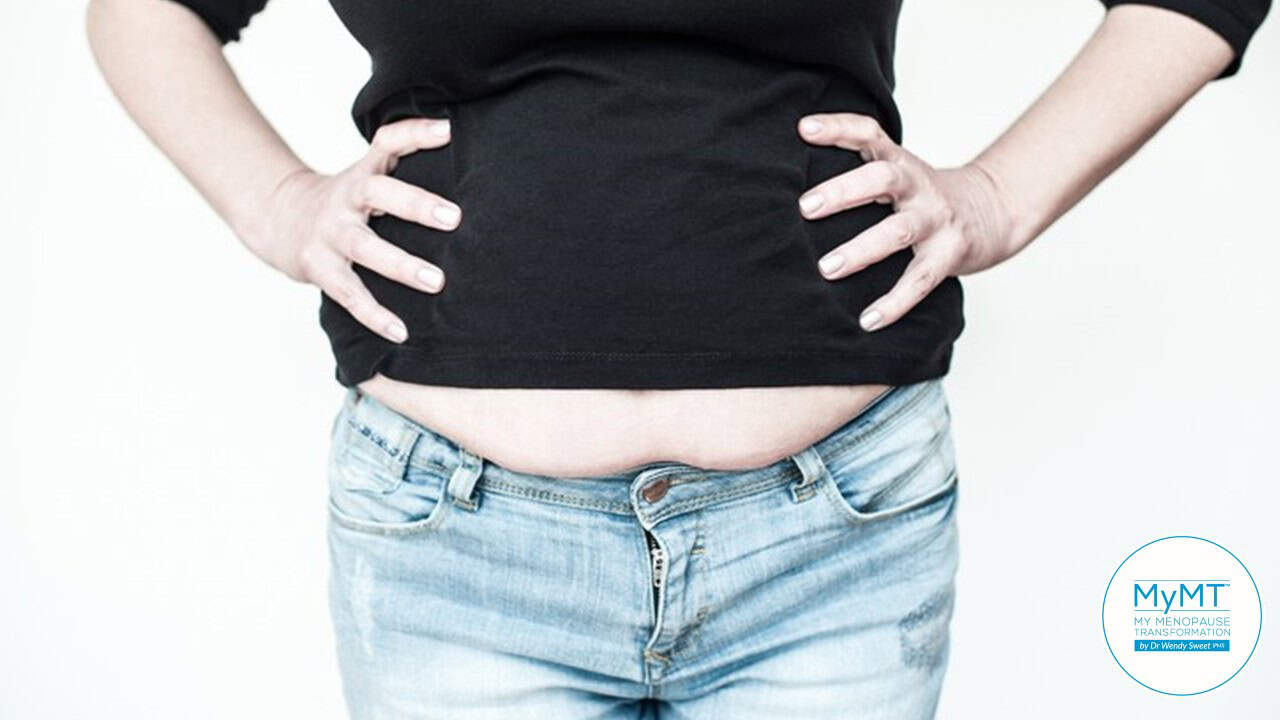Imagine being a subject in a study whereby you are not only undergoing minor gynae surgery, but you’ve also given your permission for the surgeon to do a biopsy of your fat cells under your skin (subcutaneous adipose tissue) as well as the fat cells deeper around your organs (visceral fat).
I would like to thank the lovely peri-menopausal and post-menopausal women in Denmark who consented to this. It helps me to help those of you in post-menopause better understand why you are putting on abdominal and diaphragmatic fat, that your current exercise and dieting may not be shifting.
Whilst the study was a small one (no surprises there), the subjects (women between the ages of 45-60 years) helped scientists to broaden their understanding about post-menopause obesity.
The study found that our menopause transition was associated with changes in the characteristics of fat cells (adipose tissue) and this is related to metabolic dysfunction. In post-menopausal women (when periods have ceased for a year or more), subcutaneous fat nearer the skin showed fat cell enlargement (hypertrophy), increased inflammation and lack of oxygen (hypoxia).
These subcutaneous fat changes then led to an increase in fat storage more deeper in the abdominal region – the type of fat that is called visceral fat. (Abildgaard, Ploug et al, 2021). As the authors mentioned,
“For a given total fat mass, postmenopausal women store significantly more VAT (visceral adipose tissue) than pre-menopausal women.” (p. 1).
The authors believe that the mechanisms behind the redistribution of fat as women move through menopause into post-menopause may be due to spillover of lipids (fats) from subcutaneous fat stores and then these are re-directed towards less favourable locations deep inside the abdomen.
These deeper fat stores are known as visceral fat … and for women who are post-menopause, this type of fat may lead to changes to insulin levels and increasing circulatory inflammation too.
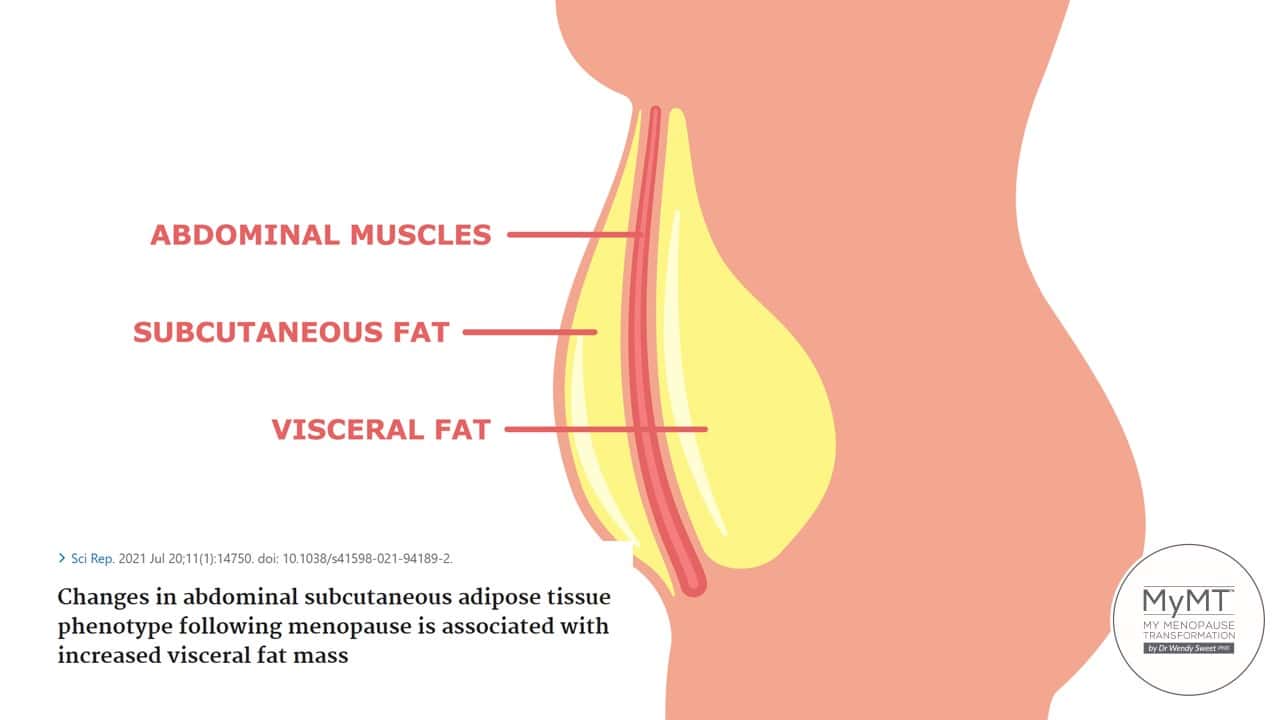
But here’s the curiosity. When we have more deep visceral fat around our abdomen, the fat cells change in ways that causes them to make different types of oestrogen.
Whilst both oestrone and oestradiol production (two different types of oestrogen) in visceral adipose tissue increase with worsening weight gain (known as adiposity). As such, Hetemäki, Savolainen-Peltonen, et al, (2017) have suggested that as women acquire more deep visceral fat stores and the fat cells expand, overall higher oestrogen exposure in post-menopausal women can occur.
Despite a challenge to the term ‘oestrogen dominance‘ these days, I like this term. I refer to it in my 2 hour Masterclass on Menopause in a way that describes how fat cells which produce and store oestrogen, expand and become enlarged (this term is called ‘hypertrophy’).
This contributes to localised production of oestrogen in fat cells in women who are overweight and obese. As such, they become ‘dominant’ in oestrogen storage in their body. When this happens, and weight around the belly and diaphragm continues to increase, post-menopausal women especially, may head down the slippery slope towards metabolic chaos and Type 2 diabetes, which the wrong type of diet and exercise doesn’t necessarily shift.
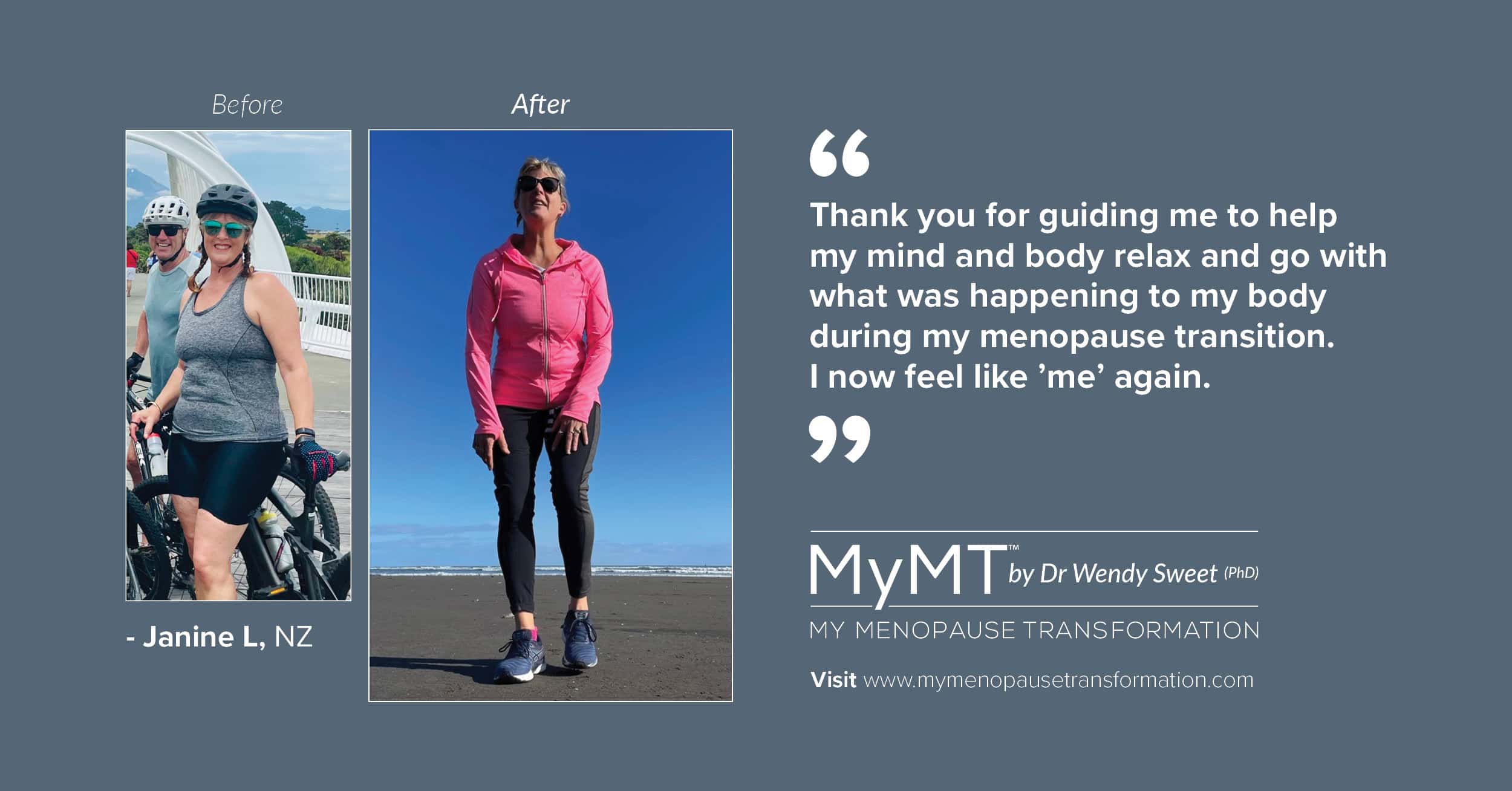
Post-menopause weight gain is tricky to navigate. This is especially so, if women are not sleeping. If we aren’t sleeping, then the circadian pattern of how fat cells function is interfered with making menopausal and post-menopausal weight loss tougher. This is why, I always tell women on my 12 week programmes that if they want to lose weight, then they must attend to their sleep patterns first.
When it comes to weight loss in menopause and beyond, I often say in my coaching programmes that menopause itself isn’t the issue. This is a natural life stage that we all go through. The issue is that we are ageing.
And because we are ageing, we are not only experiencing changes to characteristics of fat cells, but declining oestrogen (and the master pituitary hormones) also impact our muscle density and function. For post-menopausal women (whether they are on HRT or not), this becomes a double-whammy – fat cells are expanding and muscle tissue is becoming less metabolically active. These two issues combined, may mean that fat becomes increased around the abdomen and our deep visceral fat storage changes.
For many women, this can lead to changes with our heart-health and it’s why, in post-menopause women, the risk for cardio-vascular disease (heart attacks and strokes) are higher than men.
Incredibly, because of our muscle loss as we move into post-menopause, we can add 1-2 kg a week during menopause when we can’t sleep, with much of this going on our belly and under our diaphragm. Then, if we aren’t sleeping, or our joints feel sore, or our gut health is changing, it’s hard to get on top of how to lose weight or, as I mention to women on my programme, “you must firstly, stop gaining.”
The women who join me on the MyMT™ Transform Me programme, know that turning around post-menopause belly-fat has nothing to do with hours spent exercising, or low carb, high protein, high fat, hard-to-adhere to, popular diets. It’s all to do with sleeping all night so that, first and foremost, we stop gaining fat.
Then it’s about balancing our blood-sugar levels and reducing the impact of insulin, our blood sugar regulation hormone. Along the way, we also need to focus on giving ourselves a liver rescue so that excess oestrogens in our food chain and environment are metabolised and cleared.
If we have high levels of oestrogens in our diet and through environmental exposure (xeno-oestrogens), then our fat cells store the excess. Our fat cells love oestrogen and store this readily. It’s why for many women, they find it confusing as to why doing lots of exercise, doesn’t necessarily help them to lose their belly-fat.
That’s partly why, the starting point for post-menopause weight loss, lies with sleeping all night and the health of the liver, not lots of exhausting exercise.
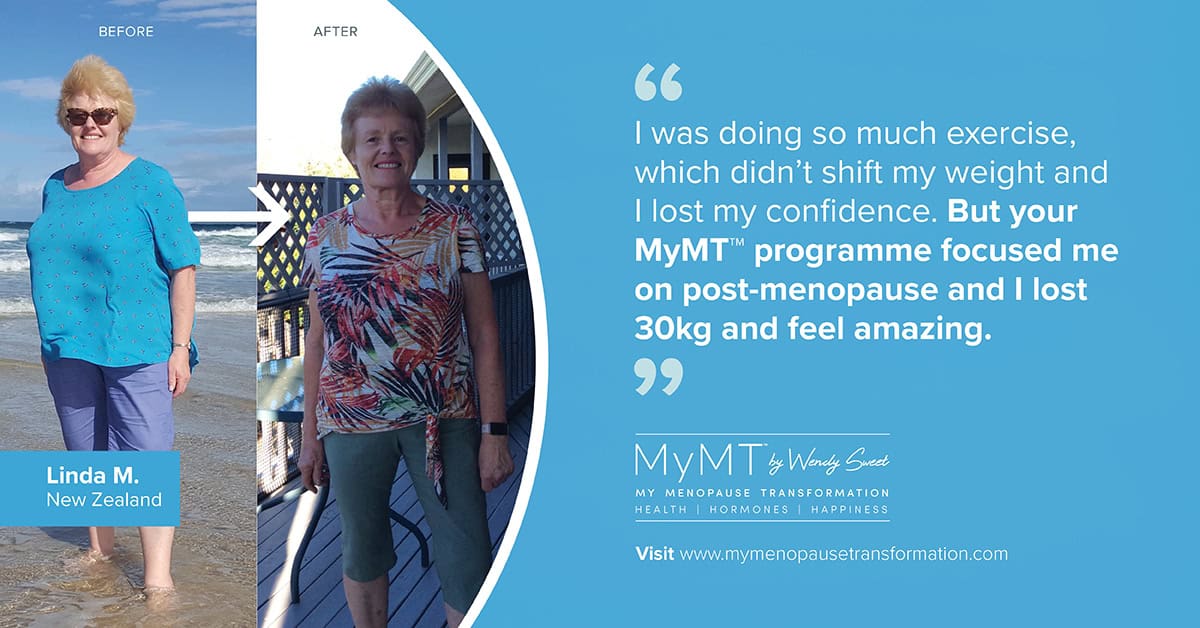
So, if you are as bewildered as I was, here’s the real (and new) science behind managing your menopause weight gain:
- Not sleeping increases your blood-sugar hormone called insulin – both overnight and during the day. The role of insulin is to shift glucose around your body, especially to your brain, liver and muscle cells where it gets stored in your cells. But when we don’t sleep, our blood pressure and heart rate remain higher during the day, which in turn increases two hormones which impact weight gain – insulin and our chronic stress hormone, called cortisol. To lose belly-fat and change our risk for Type 2 diabetes in post-menopause, both insulin and cortisol need to be low, especially at night. If they remain high, they interfere with the production of your sleep hormone called ‘melatonin‘.
As we prepare to go to sleep and stay asleep, then melatonin levels should be as high as they can be. This is why I teach women what to do to achieve the right balance between melatonin and insulin production as part of the first module they listen to in their private learning area on the 12 week MyMT™ Transform Me programme (on sale throughout July HERE). If you want to start losing weight, you must sleep.
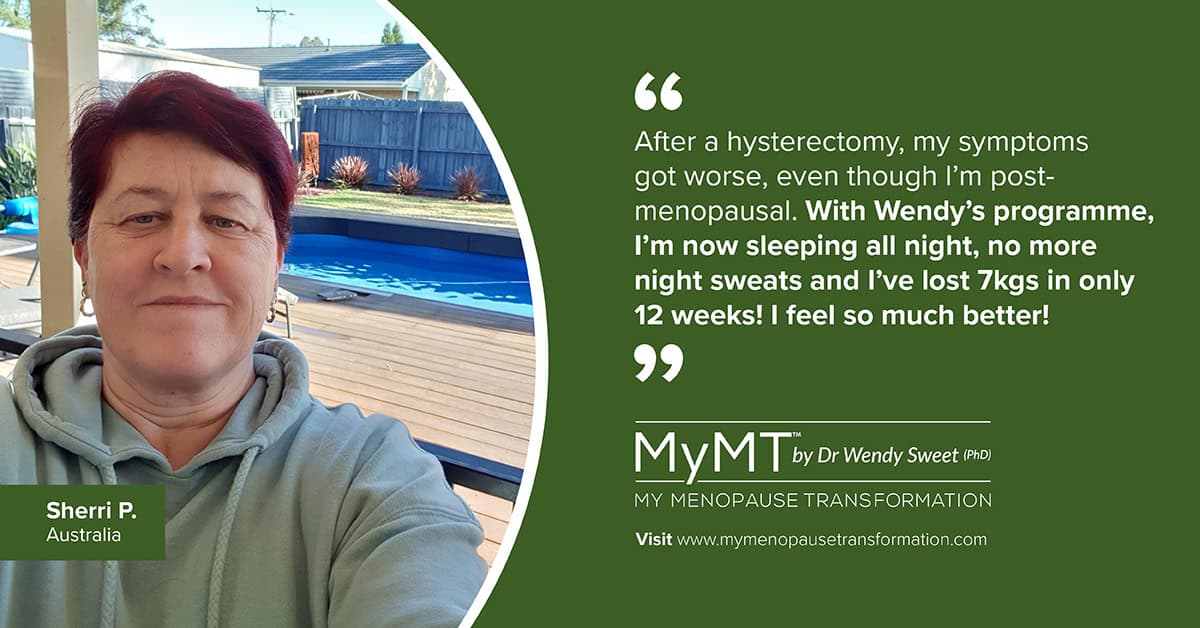
- In post-menopause, testosterone production increases if you still have your ovaries – this disrupts insulin and cortisol. Your body is amazing. Never forget that. As women going into post-menopause, if we still have our ovaries, we are producing some testosterone. If we have a lot of stress in our lives, then this impacts cortisol and testosterone production too. Managing your stress levels is an important part of menopause weight management.
We all have varying degrees of testosterone being produced as we age and some of you stronger, larger ladies with an adrenal or pituitary body-type might produce more as well. But levels of this hormone go UP when you are feeling stressed, causing even more production of your stress hormones and a chronic stress hormone known as cortisol. The powerful combination of higher testosterone and high cortisol keeps your belly fat increasing.
Testosterone is an androgen, or sex-related hormone. It is produced in your ovaries, adrenal glands and fat cells. In women, testosterone contributes to over 200 actions in our body, from muscle development, to growing facial hair on our chins, to influencing anger and frustration. In natural menopause, androgen levels don’t suddenly drop, but at this time of life, you are producing about 50% less than in puberty, which is often the cause of women losing their libido and mojo at this time as well!
But there is something else affecting your weight gain during menopause as well – your decline in muscle.
I call it the ‘forgotten factor’ in understanding menopause weight gain. A condition called sarcopenic obesity due to muscle changes may arrive during menopause and into post-menopause. Furthermore, sore joints may be preventing you from doing the aerobic exercise you need to do, in order to reduce insulin resistance.
- Muscle loss in post-menopause contributes to lowered metabolism and fat gain. When we lose oestrogen as a normal outcome of our changing biology, we also lose muscle size and density. It’s a condition called sarcopenia, which is a fancy name for muscle loss. If we aren’t sleeping, then the muscle loss speeds up as your metabolism changes because you aren’t getting the benefit of muscle recovery overnight – even for those of you doing weights.
When we don’t sleep, as I mentioned earlier, one of our chronic stress hormones, called cortisol remains high. An outcome of this may be that as you lose muscle density, then you also lose the number and size of mitochondrial cells. These beautiful cells store oxygen and this is where fat is burned.
In menopause and as a natural part of our biological ageing, we lose precious mitochondrial cells and this wrecks havoc on menopause fat-burning potential. Hence, doing aerobic exercise to boost our mitochondria cells is important, but as I said, get your joints and aching muscles sorted first.

“It’s important to understand how women’s bodies change as they age because women have higher rates of some diseases than men”, said Ananthan Ambikairajah, a PhD candidate at the Australian National University, investigating changes to fat mass in women. “The implications are important, because central fat has been linked with dementia risk, and central fat is linked with cardiovascular disease risk. More attention needs to be paid to central fat accumulation, because that’s the bad stuff,” mentioned Ambikairajah.
ALL of these factors combined – not sleeping, increased insulin, high stress levels, testosterone changes and loss of muscle tissue – have the greatest impact on our changing health and weight gain as we move into post-menopause.
I would love you to transition through menopause and into post-menopause using the powerful lifestyle strategies which I’ve researched specifically to help you manage your symptoms and turn around the weight that may have stacked on as it did for me too.
I called the 12 week weight loss programme ‘Transform Me’ because that’s what I wanted to achieve during menopause when I felt bloated and uncomfortable and exercise and nutrition wasn’t shifting my weight as it used to do for years. After I looked into menopause and positioned it in women’s healthy ageing studies, I began to understand why. If you would like to learn more, then when you have time, then please visit the My Menopause Transformation website and join me as soon as you can. I can’t wait to help you too.
References:
Ambikairajah, A., Walsh, E., Tabatabaei-Jafari, H., & Cherbuin, N. (2019). Fat mass changes during menopause: a metaanalysis. American Journal of Obstetrics and Gynecology, 221(5), 393-409. https://doi.org/10.1016/j.ajog.2019.04.023.
Abildgaard J., Ploug T., Al-Saoudi E., Wagner T., Thomsen C., Ewertsen C., Bzorek M, Pedersen BK, Pedersen AT., & Lindegaard B. (2021). Changes in abdominal subcutaneous adipose tissue phenotype following menopause is associated with increased visceral fat mass. Sci Rep. 11(1):14750. doi: 10.1038/s41598-021-94189-2. PMID: 34285301; PMCID: PMC8292317.
Edwards, B. & Jin Li, [2013]. Endocrinology of menopause. Periodontology, 61, 177–194.
Ford, C. et al. [2017]. Evaluation of diet pattern and weight gain in postmenopausal women enrolled in the Women’s Health Initiative Observational Study. British Journal of Nutrition, 117, 1189–1197.
Harvard Health, [2018]. Lose weight and keep it off. Harvard Health Online Publications. Boston: MA
Hetemäki, N., Savolainen-Peltonen, H., Tikkanen, M. Feng Wang, Paatela, H. et al. (2017). Estrogen Metabolism in Abdominal Subcutaneous and Visceral Adipose Tissue in Postmenopausal Women. The Journal of Clinical Endocrinology & Metabolism, 102, (12), 4588–4595, https://doi.org/10.1210/jc.2017-01474
Kendall, B. & Ester, R. [2002]. Exercise-induced muscle damage and the potential protective role of estrogen. Sports Med., 32 (2), 103-123
Lerchbaum, E. [2014]. Vitamin D and Menopause: A review. Maturitas, 79, 3-7.
Moudi, A. et.al [2018]. The relationship between health-promoting lifestyle and sleep quality in menopausal women. Biomedicine, 8(2), 34-40.
Rizzi, M. [2016]. Sleep disorders in fibromyalgia syndrome. J. of Pain & Relief, 5:2.
Ryan, M. Itsiopoulos, C. et al. (2014). The Mediterranean diet improves hepatic steatosis and insulin sensitivity in individuals with non-alcoholic fatty liver disease. Journal of Hepatology, 59(1), 138-143.
Santosa, S. & Jensen, M. (2013). Adipocyte fatty acid storage factors enhance subcutaneous fat storage in postmenopausal women. Diabetes, 62,3, 775-782, ProQuest Central.

